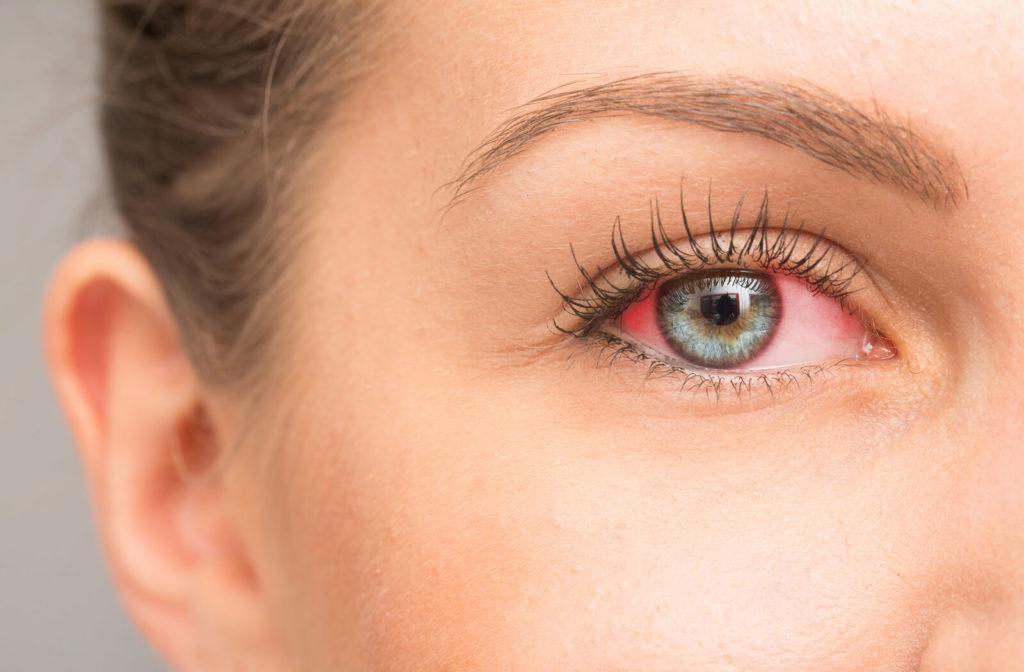You may have an eye infection if you notice your eye is red, uncomfortable, or inflamed. Many people assume an eye infection is a minor annoyance that will be gone in a few days, but this isn’t always the case. An untreated eye infection can have serious complications, and you should always visit your eye doctor when you have one.
Continue reading to learn more about eye infections, including why you should visit your optometrist for treatment.
What Is an Eye Infection?
An eye infection is a condition where viruses or bacteria attack the eye, causing irritation and inflammation. Your eyes may feel itchy, and they may look red and uncomfortable. You can develop an eye infection in several parts of your eye, including the
- Conjunctiva: The thin membrane covering the inside of your eyelids & the whites of your eyes.
- Cornea: The clear surface covering the outside of your iris.
- Eyelid: The skin protecting your eyes.
Many types of eye infections exist, both minor and severe. You may experience several symptoms, depending on the infection you have.
Signs of an Eye Infection
There are many symptoms related to eye infections. You may experience several of these problems when you develop an infection, including:
- Blurry or distorted vision
- Eye discomfort
- Eye redness
- Fever with no other cause
- Foreign object sensation
- Light sensitivity
- Yellow, green, or watery eye discharge
Types of Eye Infections
Many types of eye infections exist, and each affects your eyes differently. Some infections are less serious, while others can place your vision at risk.
Some common types of eye infections include:
Conjunctivitis
Conjunctivitis (pink eye) is inflammation or infection of the conjunctiva. Several types of pink eye exist, caused by bacterial or viral infections or an allergic reaction. Pink eye can be contagious, but it rarely threatens your vision.
The types of conjunctivitis include:
- Allergic: Allergic pink eye occurs due to exposure to allergens like pollen, dander, & other irritants. It’s noncontagious & typically resolves after removing the triggering allergen.
- Bacterial: Bacterial pink eye develops when bacteria enter the eye through contact. Touching your eyes with dirty hands & sharing makeup can cause this infection.
- Viral: Viral pink eye develops due to common cold viruses. Someone sneezing or coughing near your face can cause this infection.
Uveitis
Uveitis is a form of eye inflammation affecting the middle tissue layer in the eye, the uvea. Uveitis can appear suddenly and worsen quickly, affecting several aspects of your eye health. It can lead to redness, discomfort, blurry vision, worsened vision, and light sensitivity.
Uveitis can occur for several reasons, including a viral or bacterial infection. If left untreated, this condition can lead to vision loss.
Keratitis
Keratitis is inflammation of your cornea, typically caused by injury, contaminated contact lenses, viruses, bacteria, or contaminated water. Someone with keratitis may experience red eyes, blurry or decreased vision, light sensitivity, or difficulty opening their eyelids.
Without proper treatment, keratitis can lead to chronic inflammation, infections or potential vision loss.
Endophthalmitis
Endophthalmitis is severe inflammation within the eye caused by an infection. There are 2 main forms of endophthalmitis:
- Exogenous endophthalmitis: An infection enters the eye from an external source.
- Endogenous endophthalmitis: An infection spreads to the eye from somewhere else in the body.
Endophthalmitis can lead to potential vision loss if left unaddressed.
Stye
A stye (sty) is a painful lump around the edge of your eyelid, causing discomfort and swelling. You may mistake a stye for a pimple because of the similar look. This condition isn’t a pimple—it occurs due to an infection of the oil glands in your eyelids.
Touching your eyes with dirty hands, inserting contaminated contact lenses, leaving eye makeup on overnight, or having a preexisting skin condition can lead to a stye.
A stay is typically harmless, disappearing within a few days. In the meantime, you can relieve discomfort by applying a warm washcloth to the stye for 5 to 10 minutes. Visit your eye doctor if a stye doesn’t go away or redness and swelling progress to other parts of your face.
Why Should You Visit Your Optometrist for an Eye Infection?
You may have had a previous eye infection that went away on its own, making you wonder why you should have to visit your eye doctor. While it’s true that some infections can go away with time, there’s always the possibility of potential complications. Your risk of complications depends on your infection.
Some possible complications of an eye infection include:
- Corneal ulcers
- Dacryocystitis
- Damage to the retina
- Meningitis
- Orbital cellulitis
- Scar formation
- Vision loss
An untreated eye infection can lead to worse infections, swelling of the eye’s drainage system, blisters on the cornea, or even vision loss. For your safety, always visit your eye doctor if you experience symptoms of an eye infection. They can assess your eye and recommend a treatment plan to relieve your symptoms.
Don’t Ignore an Eye Infection
Always visit your eye doctor if you think you have an eye infection. Even if the infection is minor, your doctor can recommend ways to relieve your symptoms or improve your comfort as the issue subsides. If left untreated, many infections can significantly affect the eye.
Contact River Heights Eye Care if you have symptoms of an eye infection.


